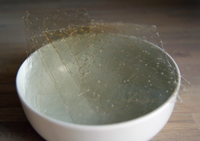
Photo from wikipedia
A straightforward method for functionalizing natural rubber (NR) with poly(N-vinylcaprolactam) (PNVCL), a temperature-responsive polymer having lower critical solution temperature (LCST) near human body temperature, has been successfully developed using free… Click to show full abstract
A straightforward method for functionalizing natural rubber (NR) with poly(N-vinylcaprolactam) (PNVCL), a temperature-responsive polymer having lower critical solution temperature (LCST) near human body temperature, has been successfully developed using free radical crosslinking reaction. Effects of polymer and initiator concentrations, reaction temperature, and reaction time on immobilization percentage of the synthesized polymer were investigated. Results showed 100% immobilization percentage when using 100 phr of PNVCL, 10 phr of benzoyl peroxide at 75 °C within 36 h. For the temperature responsiveness, the water swelling, water contact angle, and dye release of the crosslinked NR were measured. Its LCST ca. 32-34 ˚C was close to that of the pristine PNVCL. The dye adsorption studies revealed the Langmuir isotherm indicating monolayer coverage. Dye release could be triggered by increasing the temperature above the LCST, suggesting its potential uses in drug release technology. In addition, this temperature-responsive NR would potentially be used as a novel responsive rubber-based material in various applications, such as sensors and biomedical materials.
Journal Title: Macromolecular Research
Year Published: 2017
Link to full text (if available)
Share on Social Media: Sign Up to like & get
recommendations!